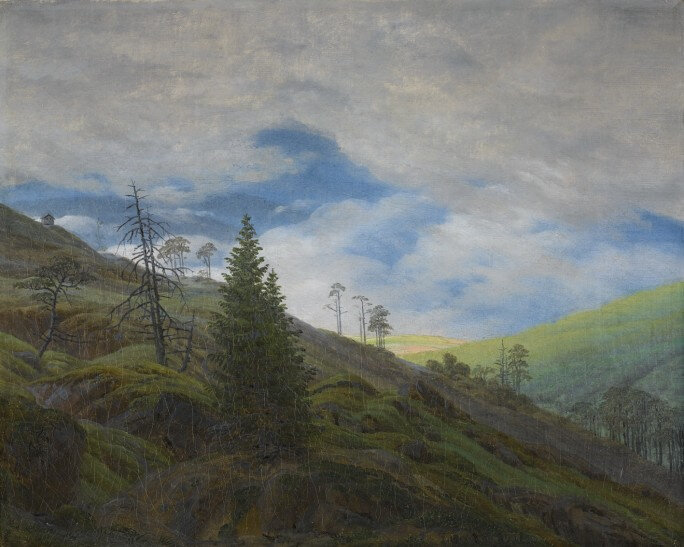Sotheby's to offer two exceptional landscapes by Caspar David Friedrich
LONDON.- Today more perhaps than at any time since Caspar David Friedrich’s death almost 180 years ago, his sublime and timeless landscapes are being appreciated by artists and public alike. The artistic embodiment of landscape painting of the Romantic era, Friedrich strove to express mood and meaning through nature, his aesthetic informed by his Protestant upbringing and the idea of divine creation manifesting itself in the natural world.
Now, on 12 December in London, Sotheby’s will offer two landscapes by Friedrich, each work a distillation of the artist’s search for deeper meaning within the appearance of nature. Both paintings come to auction with distinguished provenance: Landschaft mit Gebirgssee am Morgen (Landscape with Mountain Lake, Morning) from the collection of the late Dr Erika Pohl-Ströher (est. £2-3 million / €2.2-3.4 million) and Sonnenblick im Riesengebirge (Sunburst in the Giant Mountains) by descent through the family of the preeminent German-Swiss art dealer Dr Fritz Nathan (est. £500,000-700,000 / €560,000-780,000). Paintings by Friedrich rarely appear at auction – the emergence of these two works onto the market marks the first time in twelve years since an oil by the artist came under the hammer at Sotheby’s.
Claude Piening, Head of Sotheby’s 19th Century European Paintings in London, said: “It is enormously exciting and virtually unprecedented to see not one, but two, oil paintings by Friedrich, from completely separate sources, appear on the market at once. Friedrich was the father of German Romanticism and of modern German art, not to mention one of the defining European artists of the nineteenth-century. His legacy was so powerful, and his immediately recognisable, timeless style even today captures the imaginations of artists and the public alike. The rarity, museum quality, and exceptional provenance of both of these paintings is sure to generate great excitement among private and institutional buyers alike.”
While Friedrich was an exacting student of the landscape, and though his paintings give the impression of the greatest appearance of actuality, his landscapes were, in fact, contructs of his own design. Landschaft mit Gebirgssee am Morgen depicts a lone wanderer in a frock coat, dwarfed by the expanse of lake and mountains beyond, pausing for a moment to take in the vista. Painted circa 1823-25, the work can be seen as the culmination of the artist’s developing thoughts on, and ambitions for, an Alpine landscape. While it has been suggested that the subject could be the Königssee in the Bavarian Alps, or the Eiger and Mönch peaks in the Bernese Alps, the exact reproduction of a Swiss Apline view was never Friedrich’s objective. He rarely delivered a topographically realistic view of a subject, preferring instead to give free reign to his imagination, an extraordinary feat considering Friedrich himself never visited the Alps.
Caspar David Friedrich, Landscape with Mountain Lake, Morning, oil on canvas, 71.5 by 93cm. Estimate £2,000,000-3,000,000. Courtesy Sotheby's.
Friedrich approached landscape painting with quiet introspection, building meaning out of the spatial structure itself. In Landschaft mit Gebirgssee am Morgen, a dramatic sense of depth is achieved by three distinct planes: the meadow with trees, figure and animals in the foreground, in which every blade of grass and field flower is observed in minute detail; the mirror-like surface of the lake below, and the majestic framing mountains, receding into a purple mist in the background. Each band is distinguished through differences in atmospheric rendering, to intimate its symbolic meaning: the grass, flowers, firs, cattle, and the wandering figure symbolising the transience of life; the lake death; the mountains salvation and the life eternal.
Though the exact dating of the work remains open to debate, the painting abounds with references to Friedrich’s life’s work, and it is tempting to see the lone figure, in frock coat and top hat, as the artist himself – and certainly a version in microcosm of the frock-coated Rückenfigur in Der Wanderer über dem Nebelmeer (Wanderer Above the Sea of Fog) of 1818 (Hamburg, Hamburger Kunsthalle). The figure of a wanderer leading the viewer into the mood of the painting is certainly one of the artist’s trademarks. Friedrich believed he could achieve a truly spiritual, religious communication by transcribing his inner vision using landscape imagery and a vocabulary of symbols.
Sonnenblick im Riesengebirge belongs to the seven hitherto unrecorded oils discovered by lawyer and art historian Carl von Lorck between 1941 and 1943 during his cultural survey of East Prussian noble houses. For over a century lost in obscurity in the von Hahn family seat of Schloss Basedow until at least 1949, the painting's next owner was Fritz Nathan, in whose possession it remained until his death.
Both in date of execution and compositionally, particularly in its symbolic vocabulary, it comes close to Friedrich’s Landschaft mit Gebirgssee am Morgen. The rocky tumbling foreground symbolises the transience of earthly life (the dead tree a memento mori), the upright firs the faithful who will inherit eternal life, denoted by the sun-illuminated uplands in the beyond.
Friedrich’s art fell into obscurity for much of the nineteenth century before being rediscovered by the avant-garde in the 1890s and by many living artists today, including Gerhard Richter.
Caspar David Friedrich, Sonnenblick im Riesengebirge (Sunburst in the Giant Mountains), oil on canvas, 25.5 by 32cm. Estimate £500,000-700,000. Courtesy Sotheby's.

/https%3A%2F%2Fprofilepics.canalblog.com%2Fprofilepics%2F1%2F0%2F100183.jpg)
/https%3A%2F%2Fstorage.canalblog.com%2F03%2F02%2F119589%2F96711876_o.jpg)
/https%3A%2F%2Fstorage.canalblog.com%2F11%2F31%2F119589%2F94773502_o.jpg)
/https%3A%2F%2Fstorage.canalblog.com%2F20%2F83%2F119589%2F94772815_o.jpg)
/https%3A%2F%2Fstorage.canalblog.com%2F26%2F72%2F119589%2F75604929_o.jpg)
/https%3A%2F%2Fstorage.canalblog.com%2F59%2F60%2F119589%2F26458628_o.jpg)





/image%2F1371349%2F20240418%2Fob_ac5c4c_telechargement.jpg)
/image%2F1371349%2F20240418%2Fob_709b64_304-1.jpg)
/image%2F1371349%2F20240418%2Fob_22f67e_303-1.jpg)
/image%2F1371349%2F20240417%2Fob_9708e8_telechargement.jpg)